This was published 5 years ago
Ranching in Patagonia: A different way to experience the mountains of Patagonia
By Jim Darby
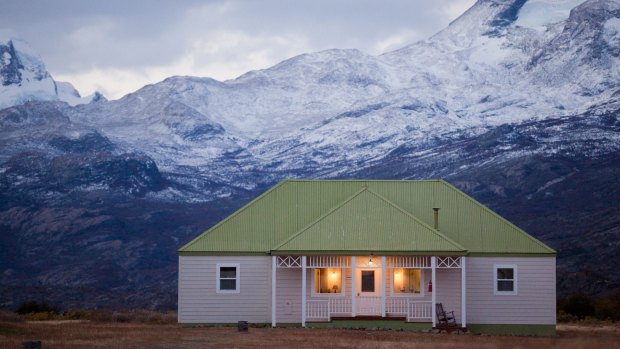
The guest accommodation at Estanca Cristina.
It's a sparkling spring morning and I'm zipping across the vast Lake Argentina in a high-speed catamaran, heading for Estancia Cristina, a remote ranch deep in the mountains of Patagonia. My cat has twin-turbo diesel motors and can move like a racing car if its skipper wants it to.
The founders of the ranch were a British couple, John Masters and Jessie Waring. They had sail and steam to push their timber boat through the wind tunnels and over the wind shadows that lurk on the lake. But that was over a century ago, in 1914, when Patagonia was a promised land for pioneering pastoralists.
They must have had a phenomenal capacity for work, along with the tenacity to overcome the transport and other challenges, bringing all their supplies in over the lake and shipping all the produce out again. But if ever they had time to stop and contemplate their surroundings, they must have been pleased with their choice.
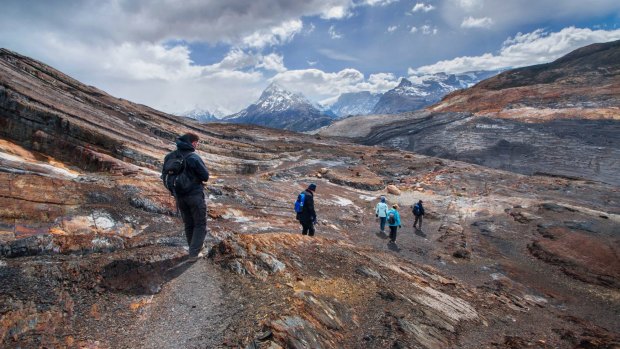
Walkers in Fossil Canyon.
Estancia Cristina is a vast land holding in a natural Shangri La, with the lake shore the boundary at one edge, massive mountain ranges enclosing it on all the other sides and glacier-fed streams and rivers flowing through the pastures.
They most likely counted their journey in days. Ours takes around three hours from Punta Banderas and we use a third of that time admiring the Upsala Glacier and the icebergs it spills from its wall into the lake. The boats' crew grapple some of the ice on board, delighting some children from parts warmer than this who handle it as though it was a piece of another planet.
When they had the 22,000-hectare ranch running at full speed, Masters, Waring and company had a flock of 12,000 sheep for wool, as well as herds of cattle and horses. They started out living in tents, eventually building the homestead and outbuildings required to run the enterprise.
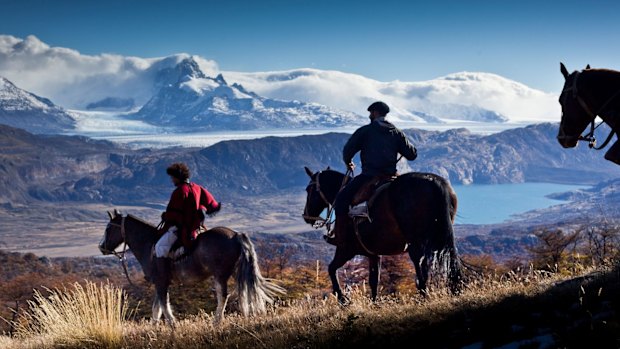
Riding the ridges with gaucho Agustin Pereyra.
It is no longer a working ranch, but those buildings now form the heart of the tourism venture that is Estancia Cristina, within Argentina's vast Los Glaciers National Park.
THE HOMESTEAD
Most of my fellow passengers are day visitors, here to explore the ranch and understand its history and maybe have a look at the glaciers above. I am taken to one side with the few other overnight guests, put aboard a massive four-wheel-drive and driven the short distance to the Octagon.
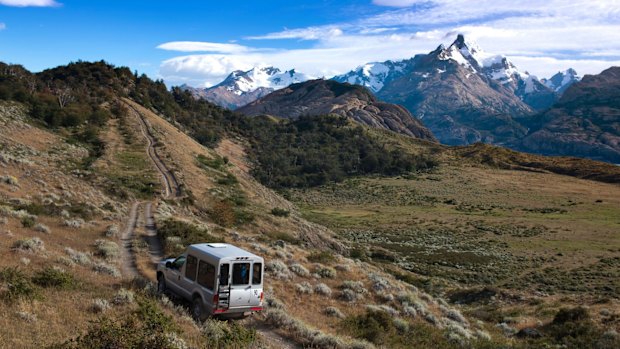
Travelling on the track to the glaciers.
This building hosts the reception, dining, lounge and bar areas and has that warm, creaking-timber feel you always find in a friendly rural homestead.
A little way beyond the main homestead are the lodges that house the guest accommodation; mine is called Montana and from my room, I look out big bay windows over the ranch lands to Col Norte (Mount North) a 2616-metre massif with a sharp peak and hanging glaciers clinging to its sides like candle wax.
The food, while simple enough, is very good. This is, after all, an area of abundance, with plenty of fresh fruit and vegetables, fish, beef and, naturally, lamb. Patagonia loves its lamb.
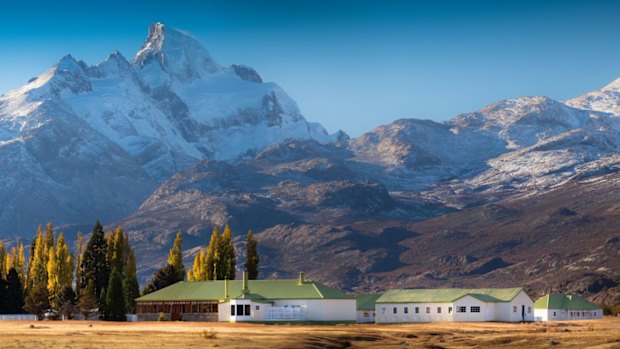
Estancia Cristina and its majestic surrounds.
At breakfast they steered me towards Patagonia's war on Nutella – Dulce de Leche – the outrageously sweet caramel spread made from condensed milk. A little less sugary was the calafate jam (calafate is a local berry, indigenous to Patagonia, hence the town El Calafate).
For overnight guests, guided hiking, fishing, horse riding and 4WD tours are included. The surroundings are so good, the atmosphere so relaxed and the views so absorbing, it is the perfect place to sit back, read and reflect, but the outdoors beckon ...
THE HORSES
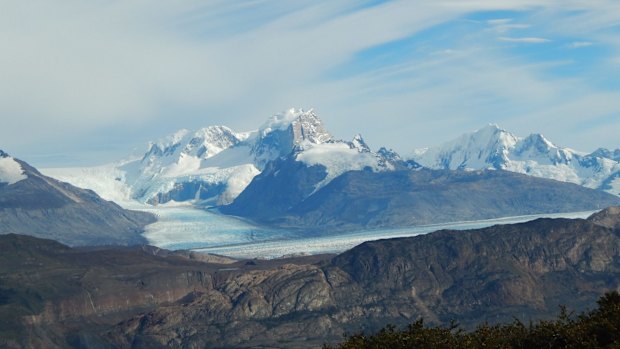
Glaciers above Estancia Cristina: Upsala in the foreground, Murallon glaciers and the peak, Cono, at 2337 metres.
When they were going strong in the conquering and colonising business, the Spanish shipped horses to their South American outposts and from those Andalusian and Arabian ancestors, the stocky and stoic Criollo breed emerged.
"They're the tough ones from the pampa, they are very rustic and very good for this life; their temperament is perfect for this," says Lucia Cataldi, my ride guide for the day.
She would know – Lucia is a vet by profession but grew weary of neo-natal work for polo ponies back in Buenos Aires (polo is a major industry in Argentina and crucial in the social structure; unlike thoroughbred breeders, polo breeders can transfer embryos, so surrogates are used for breeding "so the good mares can keep being ridden for the polo").
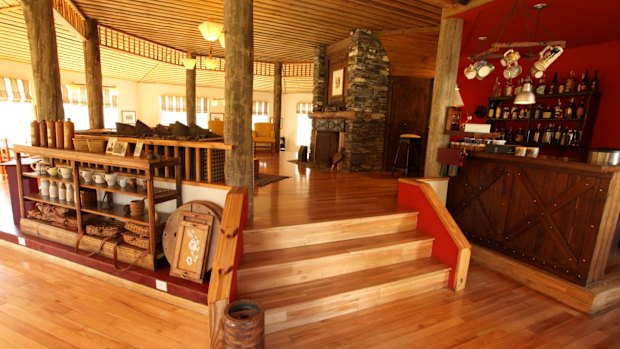
The bar and restaurant inside the Octagon building.
Her boss at Cristina is Agustin Pereyra, the beret-wearing gaucho. "A friend of mine knew Agustin and I thought I wouldn't mind to live in Patagonia, riding horses. This job is perfect for me, I really love riding and I am not paying. They are paying me!"
Outside the tourist season they simply let the horses go – they have a 22,000-hectare natural corral and no predators to speak of. Such is his touch with the horses, they say when it is time for them to get back to work in spring, Agustin simply wanders upriver to find them; he calls and they come.
"I am not a gaucho, I grew up in a town," Lucia says. "But Agustin is a gaucho, he grew up on a farm. I like the way they live and their philosophy. They are very spiritual people. They are very nice people."
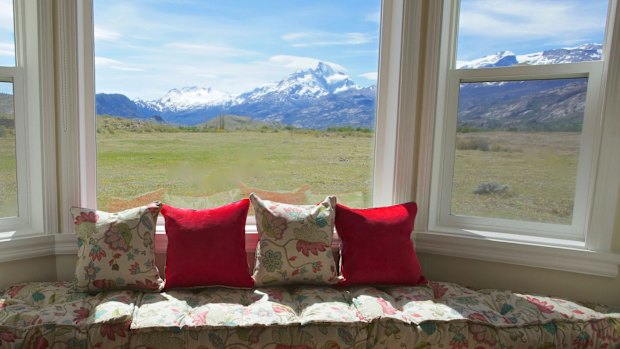
The view from one of the guest cabins with Monte Norte in the distance.
It carries through. My horse, India, is so relaxed she may as well have spent the off-season at a meditation retreat. For riders who like to click it up a gear, the horses have some go in them, but it suited me to amble along at a walking pace.
That we did, along the pampa, scaring the jack rabbits from their relentless nibbling, admiring the mountains and their snowy tops, interrupting pairs of Patagonian geese as they honk and flap to mark their territory.
We cross rivers and streams with water as clear as ice and almost as cold. The temperature doesn't worry the horses as they wade along, each hoof thinking its way along the river bed, feeling for a foothold on the smooth stones.
My riding boots are 10 years old and even though they have an outback heritage, like most who own boots from the brand, I've never taken them for a ride. Surprise, surprise, they are well-suited to the outing.
THE CANYON
Somehow it reads better in Spanish: Canadon de Los Fosiles. Today, we're on a 14-kilometre walk through the Fossil Canyon, from the glacier country way above the ranch down through an ancient canyon with a stroll along the flatter pastures and river country to take us back to the homestead.
The first leg is a bumpy 4WD trip from the homestead up an old track to a viewpoint for the glaciers. A little way along we spot a small mob of cattle, remnants from Cristina's ranching days. They are gradually reducing in number, being culled for the damage they do to certain sensitive areas of the national park.
The track is carved into the hills by Argentina's Antarctic division, which built huts along the way and a refuge at the top to train their people for work down south. It's a likely spot for training: at the top of the track we look out over a vast sea of ice formed from three glaciers – Upsala is the biggest but there's also Murallon and Cono stumbling into it, split by a 2337-metre peak called Cono to the west.
I'd only been in Patagonia a few days and each of them has been still and sunny. The locals I'd met, disarmingly honest, had all said "it isn't like this; it is nearly always windy in Patagonia".
"If you have such reliable winds, why don't you use the wind to power the Estanca?" I ask one of the staff. "The windmills have a brake to stop them when the wind gets too strong," he says, "but our winds can be so strong off the mountains, the wind would break the brake."
The weather is making up for it this morning. We are only at 500-metres altitude, but the wind is whipping a polar chill up off the glaciers in the distance. In the 1930s, a photographer came to shoot the glaciers and there was ice in the very spot we were standing, but the glacier is kilometres away now.
I could spend hours here admiring the mountain peaks and the glaciers they shrug off and the flinty terrain all around – once-massive rocks crunched to pieces by the glaciers – but it's a fair walk back to Cristina, and my walking companion, an aircraft engineering guru from Seattle, is carrying a few replacement parts in his legs, so the going needs to be steady. That's fine with me.
Our guide through the Fossil Canyon is Diego Jaramillo, a Patagonian by birth ("yes, I am from Argentina, but I'm really from Patagonia, a town called Rawson, near the coast").
Diego is typical of the staff here – delighted to be surrounded by this landscape and equally happy to share it. He has a strong grasp on the geology and the fauna and if he isn't entirely sure about the flora, he has a handy guide in his backpack to settle any arguments.
It's a steady downhill stroll most of the way, with some streams alongside. As the canyon walls grow higher and steeper, a couple of condors soar overhead, with a wingspan they count in metres.
There are plenty of birds and lower down some rabbits. With luck, you might see some Patagonian llama and with a lot more luck, a puma. Diego has never seen one. "I really, really, want to see one of those pooma," he says.
The canyon walls reveal 170 million years of history – this was once part of Gondwanaland and once lay beneath the sea; squid tentacles and clear impressions of jellyfish are tattooed into the rock.
The walk eventually leaves the canyon and winds its way along by the streams back to the homestead.
We don't see another soul for the entire trek, something to make my walking companion smile. His son runs a national park back home in the US, in Montana, and many of his working hours relate to crowd control. "No people, that's what I love about Patagonia," he says.
TRIP NOTES
MORE
FLY
LATAM flies direct from Melbourne and Sydney to Santiago with connections through to Buenos Aires and El Calafate; see latam.com
STAY
The ranch operates from mid-October to mid-April. Transfers, accommodation, meals and activities at Estancia Cristina are in an all-inclusive package starting at $US580 a person, twin share, with deals available for longer stays. A minimum three-night stay will give the best return. See estanciacristina.com and southamericatravelcentre.com.au
Jim Darby travelled as a guest of Estancia Cristina, LATAM and the South American Travel Centre.
Sign up for the Traveller Deals newsletter
Get exclusive travel deals delivered straight to your inbox. Sign up now.